Information Technology Reference
In-Depth Information
Figure 10.1 illustrates the effect of the linear inverse problem's solution. From a
scalp potential distribution one can estimate accurately the original cortical
potential.
Fig. 10.1. Electrical activity estimation in the Brodmann area 7 from the scalp measurement in the
parietal sensor P3.
10.2. Functional Connectivity Estimation
Among the linear and nonlinear methods used to estimate functional brain
connectivity, frequency-based methods are particularly attractive for the analysis
of EEG or MEG data, since the activity of neural populations is often best
expressed in this domain. Many EEG and/or MEG frequency-based methods that
have been proposed in recent years for assessment of the directional influence of
one signal on another are based mainly on the Granger theory of causality.
Granger theory mathematically defines what a “causal” relation between two
signals is. According to this theory, an observed time series x(n) is said to cause
another series y(n) if the knowledge of x(n)'s past significantly improves
prediction of y(n); this relation between time series is not necessarily reciprocal,
i.e., x(n) may cause y(n) without y(n) causing x(n). This lack of reciprocity
allows the evaluation of the direction of information flow between structures.
Kaminski and Blinowska proposed a multivariate spectral measure, called the
Directed Transfer Function (DTF), which can be used to determine the
directional influences between any given pair of channels in a multivariate
dataset. DTF is an estimator that simultaneously characterizes the direction and
spectral properties of the interaction between brain signals and requires only one
multivariate autoregressive (MVAR) model to be estimated simultaneously from

